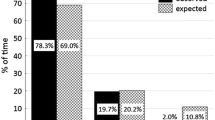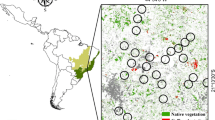Abstract
Core areas are highly used parts of the home range on which the survival of solitary or group-living animals depends. We investigated the home range and core area size and area fidelity of a spider monkey community in a tropical dry forest over a 4-year period. Home ranges overlapped extensively across years, subgroup sizes, and seasons. In contrast, spider monkeys used core areas that varied in size and location across the study years, subgroup sizes, and seasons. These shifts in core areas suggest that the understanding of core areas, and thus the spatial requirements, of a species in a particular habitat may be limited if based on short-term studies. In this respect, our findings emphasize the importance of long-term studies of the spatial ecology of any species in a particular habitat. Our study also shows that the yearly home range basically includes all the core areas from different years, seasons, and subgroup sizes (i.e., the super-core area). This is conceptually important for territorial species, such as spider monkeys, which defend a stable home range as it contains not only the current, but also the future core areas.






Similar content being viewed by others
References
Arroyo-Mora JP, Sánchez-Azofeifa GA, Kalacska MER, Rivard B, Calvo-Alvarado JC, Janzen DH (2005) Secondary forest detection in a neotropical dry forest landscape using Landsat 7 Etm+ and Ikonos imagery. Biotropica 37:497–507
Asensio N, Korstjens AH, Schaffner CM, Aureli F (2008) Intragroup aggression, feeding competition and fission–fusion sociality in spider monkeys. Behaviour 145:983–1001
Asensio N, Korstjens AH, Aureli F (2009) Fissioning minimizes ranging costs in spider monkeys: a multiple-level approach. Behav Ecol Sociobiol 63:649–659
Aureli F, Schaffner CM (2008) Social interactions, social relationships and the social system of spider monkeys. In: Campbell CJ (ed) Spider monkeys: behavior, ecology and evolution of the genus Ateles. Cambridge University Press, New York, pp 236–265
Beyer HL (2004) Hawth’s analysis tools for Arcgis. http://www.spatialecology.com/htools. Accessed in June 2011
Bingham BB, Noon BR (1997) Mitigation of habitat “take”: application to habitat conservation planning. Conserv Biol 11:127–139
Bodmer RE, Eisenberg J, Redford K (1997) Hunting and the likelihood of extinction of Amazonian mammals. Conserv Biol 11:460–466
Burgman MA, Fox JC (2003) Bias in species range estimates from minimum convex polygons: implications for conservation and options for improved planning. Anim Conserv 6:19–28
Burt WH (1943) Territoriality and home range concepts as applied to mammals. J Mammal 24:346–352
Chapman CA (1988) Patterns of foraging and range use by three species of neotropical primates. Primates 29:177–194
Chapman CA (1990) Association patterns of spider monkeys: the influence of ecology and sex on social organization. Behav Ecol Sociobiol 26:409–414
Chaves OM, Stoner KE, Arroyo-Rodriguez V, Estrada A (2011) Effectiveness of spider monkeys (Ateles geoffroyi vellerosus) as seed dispersers in continuous and fragmented rain forests in southern Mexico. Int J Primatol 31:177–192
Clarke MF, Burke Da Silva K, Lair H, Pocklington R, Kramer DL, Mclaughlin RL (1993) Site familiarity affects escape behaviour of the eastern chipmunk Tamias striatus. Oikos 66:533–537
Clifford P, Richardson S, Hemon D (1989) Assessing the significance of the correlation between two spatial processes. Biometrics 45:123–134
Costello CM (2010) Estimates of dispersal and home-range fidelity in American black bears. J Mammal 91:116–121
Cowlishaw G, Dunbar RIM (2000) Primate conservation biology. University Of Chicago Press, Chicago
De Solla SR, Bonduriansky R, Brooks RJ (1999) Eliminating autocorrelation reduces biological relevance of home range estimates. J Anim Ecol 68:221–234
Degama-Blanchet H, Fedigan L (2006) The effects of forest fragment age, isolation, size, habitat type, and water availability on monkey density in a tropical dry forest. In: Estrada A, Garber PA, Pavelka M, Luecke L (eds) New perspectives in the study of mesoamerican primates. Springer, Secaucus, pp 165–188
Di Fiore A, Link A, Campbell CJ (2010) The atelines: behavioral and socioecological diversity in a new world radiation. In: Campbell CJ, Fuentes A, Mackinnon KC, Beader SK, Stumpf R (eds) Primates in perspective, 2nd edn. Oxford University Press, Oxford, pp 155–188
Easley SP, Kinzey WG (1986) Territorial shift in the yellow-handed titi monkey (Callicebus Torquatus). Am J Primatol 11:307–318
Fedigan L, Jack K (2001) Neotropical primates in a regenerating Costa Rican dry forest: a comparison of howler and capuchin population patterns. Int J Primatol 22:689–713
Frankie GW, Mata SA, Bradleight SB (2004) Biodiversity conservation in Costa Rica: learning the lesson in a seasonal dry forest. University of California Press, Berkeley
Garcia P, Lastra J, Marquínez J, Nores C (2007) Detailed model of shelter areas for the Cantabrian brown bear. Ecol Inform 2:297–307
Gonzalez-Zamora A, Arroyo-Rodriguez V, Chavez O, Sanchez-Lopez S, Stoner KE, Riba-Hernandez P (2009) Diet of spider monkeys (Ateles geoffroyi) in Mesoamerica: current knowledge and future directions. Am J Primatol 71:8–20
Harris S, Cresswell WJ, Forde PG, Trewhella WJ, Woollard T, Wray S (1990) Home-range analysis using radiotracking data: a review of problems and techniques particularly as applied to the study of mammals. Mammal Rev 20:97–123
Hellickson MW, Campbell TA, Miller KV, Marchinton RL, Deyoung CA (2008) Seasonal ranges and site fidelity of adult male white-tailed deer (Odocoileus Virginianus) in southern Texas. Southwest Nat 1:1–8
Hillen J, Kiefer A, Veith M (2009) Foraging site fidelity shapes the spatial organisation of a population of female western Barbastelle bats. Biol Conserv 142:817–823
Hulbert SH (1984) Pseudoreplication and the design of ecological field experiments. Ecol Monogr 54:187–211
IUCN (2010) IUCN red list of threatened species. Version 2010.4. http://www.iucnredlist.org. Accessed in June 2011
Janmaat KRL, Olupot W, Chancellor RL, Arlet ME, Waser PM (2009) Long-term site fidelity and individual home range shifts in Lophocebus Albigena. Int J Primatol 30:443–466
Janzen DH (1983) No park is an island: increase in interference from outside as park size decreases. Oikos 41:402–410
Janzen DH (1986) Guanacaste National Park: tropical, ecological, and cultural restoration, Costa Rica. Fundación De Parques Nacionales, Editorial Universidad Estatal Distancia, San José, Costa Rica
Janzen DH (1988) Tropical dry forests: the most endangered major tropical ecosystem. In: Wilson EO, Peter FM (eds) Biodiversity. National Academy Press, Washington, pp 130–137
Jolly A, Pride E (1999) Troop histories and range inertia of Lemur Catta at Berenty, Madagascar: a 33-year perspective. Int J Primatol 20:359–373
Kahlenberg S, Emery Thompson M, Wrangham RW (2008) Female competition over core areas among Kanyawara chimpanzees, Kibale National Park, Uganda. Int J Primatol 29:1497–1509
Kernohan BJ, Jenks JA, Naugle DE (2002) Localized movements and site fidelity of white-tailed deer in the northern Great Plains. Prairie Nat 34:1–12
Legendre P (1993) Spatial autocorrelation: trouble or new paradigm? Ecology 74:1659–1673
Leuthold W (1977) African ungulates: a comparative review of their ethology and behavioral ecology. Springer, Berlin
Lindstedt SL, Miller BJ, Buskirk SW (1986) Home range, time, and body size in mammals. Ecology 67:413–418
Link A, Di Fiore A (2006) Seed dispersal by spider monkeys and its importance in the maintenance of neotropical rain-forest diversity. J Trop Ecol 22:235–246
Mészáros AL, Kajdocsi SZ, Szentirmai I, Komdeur J, Székely T (2006) Breeding site fidelity in penduline tit Remiz Pendulinus in southern Hungary. Eur J Wildl Res 52:39–42
Michalski F, Peres CA (2005) Anthropogenic determinants of primate and carnivore local extinctions in a fragmented forest landscape of southern Amazonia. Biol Conserv 124:383–396
Minta SC (1992) Tests of spatial and temporal interaction among animals. Ecol Appl 2:178–188
Murray CM, Gilby IC, Mane SV, Pusey AE (2008) Adult male chimpanzees inherit maternal ranging patterns. Curr Biol 18:20–24
Osborne PE, Suarez-Seoane S (2007) Identifying core areas in a species’ range using temporal suitability analysis: an example using little bustards Tetrax tetras in Spain. Biodivers Conserv 16:3505–3518
Peres CA (1990) Effects of hunting on western Amazonian primate communities. Biol Conserv 54:47–59
Peres CA (2000) Effects of subsistence hunting on vertebrate community structure in Amazonian forests. Conserv Biol 14:240–253
Plowman BW, Conner LM, Chamberlain MJ, Leopold BD, Burger LW (2006) Annual dynamics of bobcat (Lynx Rufus) home range and core use areas of Mississippi. Am Midl Nat 156:386–393
Ramos-Fernández G, Wallace RB (2008) Spider monkey conservation in the twenty-first century: recognizing risks and opportunities. In: Campbell CJ (ed) Spider monkeys. The biology, behavior and ecology of the genus Ateles. Cambridge University Press, New York, pp 351–372
Samuel MD, Green RE (1988) A revised test procedure for identifying core areas within the home range. J Anim Ecol 57:1067–1068
Seaman DE, Powell RA (1996) An evaluation of the accuracy of kernel density estimators for home-range analysis. Ecology 77:2075–2085
Shimooka Y (2005) Sexual differences in ranging of Ateles belzebuth belzebuth at La Macarena, Colombia. Int J Primatol 26:385–406
Sorensen TC, Fedigan LM (2000) Distribution of three monkey species along a gradient of regenerating tropical dry forest. Biol Conserv 92:227–240
Spehar SN, Link A, Di Fiore A (2010) Male and female range use in a group of white-bellied spider monkeys (Ateles belzebuth) in Yasuni National Park, Ecuador. Am J Primatol 72:129–141
Stephens DW, Krebs JR (1986) Foraging theory. Princeton University Press, Princeton NJ
Swihart RK, Slade NA (1997) On testing for independence of animal movements. J Agric Biol Environ Stat 2:48–63
Switzer PV (1997) Factors affecting site fidelity in a territorial animal, Perithemis Tenera. Anim Behav 53:865–877
Symington MM (1988) Demography, ranging patterns, and activity budgets of black spider monkeys (Ateles paniscus chamek) in the Manu National Park, Peru. Am J Primatol 15:45–67
Symington MM (1990) Fission–fusion social organization in Ateles and Pan. Int J Primatol 11:47–61
Van Der Ree R, Soderquist TR, Bennett AF (2001) Home-range use by the brush-tailed phascogale (Phascogale Tapoatafa) (Marsupialia) in high-quality, spatially limited habitat. Wildl Res 28:517–525
Wallace RB (2006) Seasonal variation in black-faced black spider monkey (Ateles chamek) habitat use and ranging behavior in a southern Amazonian tropical forest. Am J Primatol 68:313–332
Wallace RB (2008) Factors influencing spider monkey habitat use and ranging patterns. In: Campbell CJ (ed) Spider monkeys. The biology, behavior and ecology of the genus Ateles. Cambridge University Press, New York, pp 138–154
Willems EP, Hill RA (2009) Predator-specific landscapes of fear and resource distribution: effects on spatial range use. Ecology 90:546–555
Wrangham RW (1979) On the evolution of ape social systems. Soc Sci Inf (Paris) 18:335–368
Xu J-L, Zhang X-H, Sun Q-H, Zheng G-M, Wang Y, Zhang Z-W (2009) Home range, daily movements and site fidelity of male Reeves’s pheasants Syearmaticus reevesii in the Dabie Mountains, Central China. Wildl Biol 15:338–344
Acknowledgments
We wish to thank Elvin Murillo-Chacon for the great support during the field study. We thank also all the staff from Santa Rosa National Park, especially Roger Blanco and Maria Marta Chavarria. This study was made possible due to the financial support of the Leakey Foundation, The North of England Zoological Society, and The British Academy. Norberto Asensio was supported by the Department of Political Science of the Basque Government (Zientzia Politikarako Zuzendaritza) and the Postdoc Fellowship program from Mahidol University, Thailand. We also thank all the valuable help and comments on GIS provided by Melanie Luinstra, Scott Wilson, Anne Marie Nuttall, Felix Eigenbrod, Cristina Garcia, Liz Maher, Eduardo Ogando, Eric Willems, and Warren Brockelman. Our observations complied with current laws in Costa Rica.
Author information
Authors and Affiliations
Corresponding author
About this article
Cite this article
Asensio, N., Schaffner, C.M. & Aureli, F. Variability in core areas of spider monkeys (Ateles geoffroyi) in a tropical dry forest in Costa Rica. Primates 53, 147–156 (2012). https://doi.org/10.1007/s10329-011-0288-9
Received:
Accepted:
Published:
Issue Date:
DOI: https://doi.org/10.1007/s10329-011-0288-9




